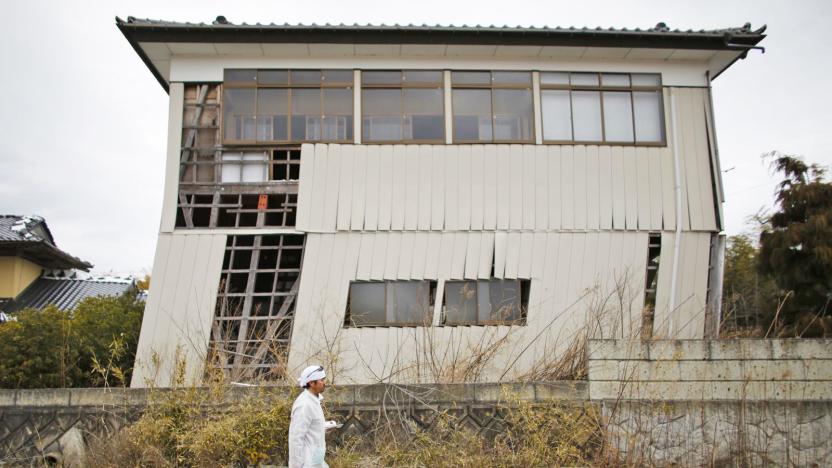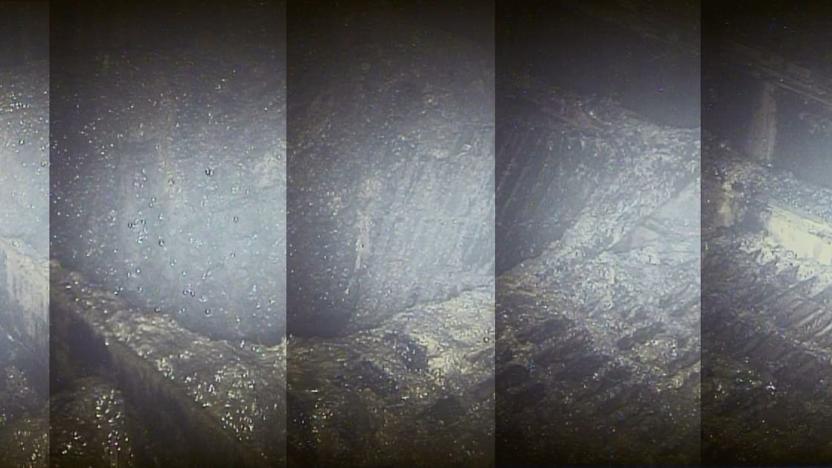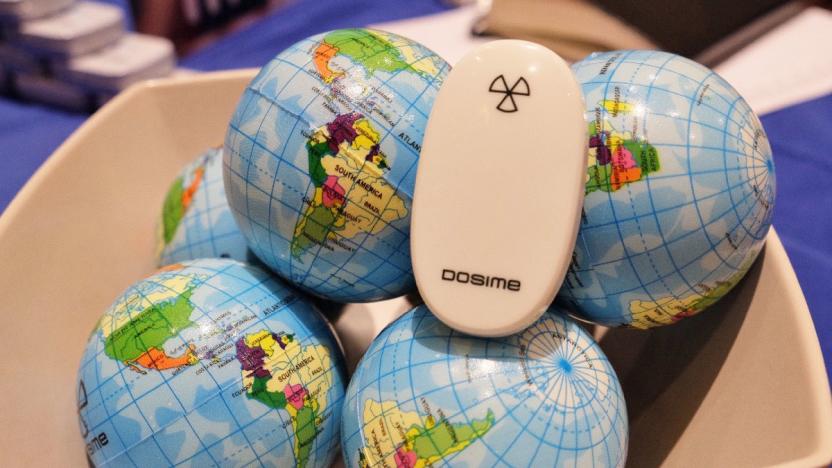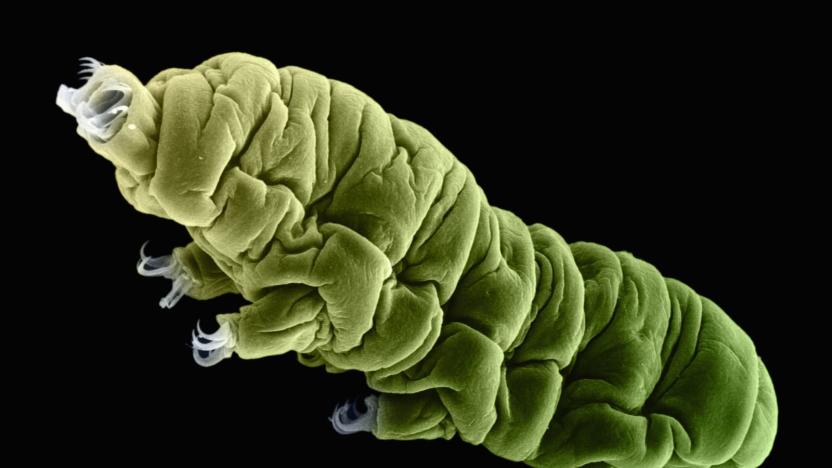radiation
Latest

Study says Fukushima region is safe enough for people to return
Fukushima's ill-fated nuclear power plant may still be so dangerous that it kills robots, but residents are trickling back as officials decide that radiation levels are safe in some areas. But are they safe enough that you'd never have to worry about long-term effects? According to two researchers, the answer is yes. They've published a study indicating that the cesium radiation levels in Date, 37 miles away from the Fukushima plant, have dropped so quickly (60 percent just between 2011 and 2013) that residents shouldn't suffer any harm. In fact, they may be safer than usual. The median lifetime radiation dose (18 millisieverts) should be less than what you typically receive just by living on Earth.

After Math: Keep pace in the space race
It's been a productive week for those of us trying to get the hell off this crazy planet. NASA showed off a radiation-proof flight vest for interplanetary astronauts while Blue Origin debuted its latest rocket engine and previewed its upcoming New Glenn spacecraft. We also take a look at a solar farm visible from the ISS and examine just how badly the Trump regime is gutting NASA's Earth Science programs. Numbers, because how else will we know when it's time to blast off?

NASA proposes guarding Mars' atmosphere with a magnetic shield
Ask scientists why Mars is cold and dead and they'll usually point to the death of its magnetic field some 4.2 billion years ago. Without that protection, solar winds gradually stripped it of most of its atmosphere. A NASA-led team, however, thinks there's still a chance to protect what's left -- and human explorers in the process. The scientists have proposed a magnetic shield that would sit at the L1 Lagrange Point beyond the planet, creating an artificial magnetosphere that would deflect solar winds and incoming radiation. Simulations even suggest that the atmosphere would get thick enough to melt carbon dioxide ice at Mars' northern pole, sparking a greenhouse gas effect that would melt water ice and restore some of Mars' oceans. Needless to say, that would be much friendlier to any long-term visitors.

Moon mission will test an anti-radiation vest for astronauts
For astronauts headed to Mars, the biggest threat might not be an unforgiving climate or dwindling supplies -- it could be gamma ray radiation that gradually wrecks their bodies. Explorers may soon have a way to shield themselves, though. StemRad has revealed that its AstroRad anti-radiation vest is set to trialed aboard the Orion capsule when it orbits around the Moon during its late 2018 dry run. The non-metallic, layered shields are custom-fitted to each astronaut in order to protect their vital organs without bogging them down.

Fukushima reactor's radiation levels killed a cleaning robot
Tokyo Electric Power Co. (Tepco) wasn't kidding when it said the radiation levels inside Fukushima's nuclear reactor are the highest they've been since its meltdown in 2011. It had to pull out the robot it sent in to find the exact location of melted uranium fuel and to do preliminary cleanup inside the reactor, because it died shortly after it started its mission. Apparently, two of the machine's cameras suddenly became wonky, darkened and developed a lot of noise after merely two hours of scraping debris away. Those are all signs of extremely high radiation levels.

Fukushima radiation skyrockets after possible fuel breach
Radiation levels inside the damaged Fukushima nuclear reactor are over 100 times fatal levels, the highest they've been since the triple meltdown in March, 2011, according to operator Tepco. The company recently sent a camera-equipped robot into the reactor, which relayed images showing a meter-wide hole in the pressure vessel (above), with possible melted uranium fuel on a grating below. "It may have ... melted and made a hole in the [containment] vessel, but it is only a hypothesis at this stage," a company spokesperson told the AFP.

These companies are banking on your fear of radiation
Imagine if, next week, every Best Buy in the land began selling a Dan Cooper-branded Fluorocarbon detector for $100. There'd be a big cardboard cutout on each aisle end, with my stern-looking face advising you to protect your family with this product. Even if you didn't instantly lay down a Benjamin for Dan Cooper's Lean, Mean, Fluorocarbon Detectin' Machine, you'd probably think about it. Maybe you'd do a cursory Google to learn more -- since they wouldn't sell the equipment for no reason, would they?

Dosime is a personal radiation tracker for hypochondriacs
One of the problems with building sensors to detect ubiquitous dangers is that those dangers remain, you know, ubiquitous. Despite this, a company called Dosime has built a portable radiation meter that will warn you about the invisible killer. The ovoid device either clips to your lapel or docks in a wall-socket-mounted cradle and will sniff the millirems in the local atmosphere. If it detects that the levels of radiation have become unsafe, it lets you know with a smartphone notification.

NASA is helping Stephen Hawking get a tiny ship to Alpha Centauri
NASA is helping Stephen Hawking and Russian venture capitalist Yuri Milner with the monumental task of getting a tiny probe to Alpha Centauri, the nearest star system to Earth. Project Starshot aims to propel a lightweight silicon "StarChip" to one-fifth the speed of light by hitting it with lasers from Earth, getting it to the star within 20 years. The space agency will help solve one of the thorniest problems -- the intense radiation of interstellar travel.

'Water Bear' protein could shield human DNA from radiation
Tardigrades, aka 'water bears,' are microscopic organisms that survive in harsh environments from the antarctic to oxygenless space. They are so robust that Japanese scientists froze a group of them for 30 years and successfully revived two specimens. But to understand what makes these tiny creatures so impervious, another group of researchers took a closer look at their genes. By mapping the entire genome of a particularly stress-tolerant tardigrade species, Ramazzottius varieornatus, they found a protein that protects DNA from being irradiated — which could be used to shield humans.

MIT uses radiation to read closed books
There are some books that are simply too delicate to crack open -- the last thing you want to do is destroy an ornate medieval Bible simply because you're curious about its contents. If MIT has its way, though, you won't have to stay away. Its scientists have crafted a computational imaging system that can read the individual pages of a book while it's closed. Their technology scans a book using terahertz radiation, and relies on the tiny, 20-micrometer air gaps between pages to identify and scan those pages one by one. A letter interpretation algorithm (of the sort that can defeat captchas) helps make sense of any distorted or incomplete text.

A lab-made black hole supports longstanding Hawking theory
In 1974, Stephen Hawking put forward a hypothesis suggesting radiation can escape the light-sucking grip of a black hole. This week, and over forty years later, newly published research claims to have observed "Hawking radiation" (as it is known) in lab conditions. How do you observe the mother of cosmic monsters in a science lab? With a sonic black hole, a commonly used analogue (that doesn't swallow your research lab).

Deep space travel might play havoc with your heart
Traveling deeper into space may carry some unanticipated health risks. Scientists have published a study noting that Apollo astronauts have died of heart disease at an unusually high rate -- of the 7 that passed away during the study, 43 percent fell to cardiovascular conditions. Only 11 percent of those deceased astronauts who stopped at low Earth orbit succumbed to heart disease, which is about on par with the 9 percent rate on the ground. There's a concern that the increased dose of radiation in deep space, however brief, is intense enough to mess with the functioning of cells that line blood vessels.

Kinect sensors could lead to safer X-rays
You don't want to stand in front of an X-ray machine for any longer than necessary, and scientists have found a clever way to make that happen: the Kinect sensor you might have picked up with your Xbox. Their technique has the depth-sensing camera measuring both motion and the thickness of your body to make sure that doctors get a high-quality shot using as little radiation as possible. That's particularly important for kids, who can be sensitive to strong X-ray blasts.

Researchers may have found a cancer cell's 'off' switch
Aside from their abnormal growth rates, cancerous cells aren't that much different from normal healthy tissue. That's why radiation and chemo treatments can't effectively target just tumors. However, a team of researchers from the Mayo Clinic believe they've discovered a mechanism that can rein in cancer's uninhibited growth by retraining these wayward cells to die like they're supposed to.

Stephen Hawking believes he knows how information escapes black holes
Stephen Hawking announced during a lecture at the KTH Royal Institute of Technology in Stockholm, Sweden on Tuesday that he has potentially solved the Information Paradox. The paradox a conflict between the quantum mechanics and general relativity models that has vexed physicists for more than four decades. The Information Paradox arises from black holes -- specifically what happens to information about the physical state of objects that fall into one. The quantum mechanical model posits that the information remains intact while general relativity argues that it is indeed obliterated under the black holes immense gravitation. But Hawking has developed a third opinion: the information never actually makes it into the black hole. "I propose that the information is stored not in the interior of the black hole as one might expect, but on its boundary, the event horizon," he said.

A radioactive drone landed on the Japanese Prime Minister's office (update: arrest)
Japan has a mystery on its hands. A worker has discovered a drone on top of Prime Minister Shinzo Abe's office that was not only carrying a water bottle, but was marked with a radioactive sign and carried a "miniscule" amount of radiation, according to officials. While the quantity wasn't enough to harm anyone, the landing raised more than a few alarms, as you can see by the giant tarp and swarm of police in the photo here. Who was behind it? And how did they get on to the roof undetected?

Curiosity rover discovers dangerous levels of radiation during Mars transit
While we've learned that radiation levels on Mars are safe for humans, actually getting there in the first place remains a problem. Recent results from Curiosity's Radiation Assessment Detector (RAD) reveal that exposure even while safely ensconced inside a protected spacecraft is dangerously high. Explorers would be bombarded with 466 milliSieverts of high-energy galactic cosmic rays and solar particles during the 253-day transit and the same coming back, with total levels that could exceed NASA's career radiation limit for astronauts. "In terms of accumulated dose, it's like getting a whole-body CT scan once every five or six days," said Cary Zeitlin, a principal scientist from the Southwest Research Institute (SwRI) who's the lead author of the findings. A manned Mars voyage isn't completely out of the question, but it does mean better shielding is necessary before such a trip -- much less a future colony -- becomes a reality.

Electron showers could create the nano-spacesuit of the future
Historically, whenever man or beast's been bombarded with massive amounts of radiation the results have either been gruesome or wholly fantastical (see: any superhero origin story). But recent research out of Japan indicates that a barrage of electrons could actually help scientists revolutionize microbiology and, more excitingly, space travel. The experiment, conducted by a team from the Hamamatsu University of Medicine, found that the larvae of fruit flies hit with this electron rush were able to withstand an electron microscope's hostile vacuum unharmed and even grew to be healthy adults. The results weren't so rosy for the untreated group which, understandably, suffered a grislier fate: death by dehydration. The magic, it turns out, is in that subatomic spray, as the group treated with an electron shower benefited from a polymerizing effect or, more plainly, a bonding of molecules just above the skin's surface that yielded a tough, protective nano-layer measuring between 50- to 100-billionths of a meter thick. Finesse that technique some and it's easy to why one NASA scientist thinks this could lead to the creation of a super-thin "space shield... that could protect against dehydration and radiation." The process is still far from foolproof, however, seeing as how an increase in the microscope's resolution requires an equal boost in radiation -- all of which is fatal to the insects. So, in order to go deeper and get a more close-up view of the larvae's internals, the team's currently exploring new methods of fabricating these "nano-suits" using an array of chemicals. If you're wondering just how far-off we are from practical human application, then consider this: the amount of radiation required to form the bonded layer is akin to "sunbathing naked on the top of Everest under a hole in the ozone." Which is to say, keep dreaming. And get Jeff Goldblum on the phone while you're at it... we have a promising idea for a Return of the Fly sequel.

FCC confident in its mobile phone radiation limits, seeks second opinions
Cast your memory back to last summer. Sweep away memories of iPhone 5 leaks galore, and you might remember that the US Government Accountability Office (GAO) asked the FCC to reevaluate its radiation limits for mobile phones. Now a few seasons later, the FCC has finally wrapped up a report that responds to the GAO, and there are no changes to its RF radiation levels in sight because it feels comfortable with its current caps. "We continue to have confidence in the current exposure limits, and note that more recent international standards have a similar basis," reads the report. However, given that its guidelines were adopted in 1996, new research on radiation and the proliferation of mobile devices, the FCC would like some feedback regarding its restrictions. It's put out a call for comments from concerned parties and even federal health and safety bodies. Though the freshly-released document didn't rock the proverbial boat, it made one change worth noting. The pinna (outer ear) is now classified an extremity, which means the FCC allows devices to hit the tissue with more radiation. Feel like poring through 201 pages of regulatory minutiae? Click the source link below for the commission's full dossier.









